World Tourism Day: September 27th, 2013 (and the visitor experience)
Friday was World Tourism Day, sponsored by the United Nations. The focus was on sustainable tourism and reducing and mitigating negative impact from tourism on the places that are visited. Hence the 2013 theme for World Tourism Day was Tourism and Water: Protecting our Common Future.
City Tourism
But rather than write about eco-tourism and the like, I am more interested in urban tourism, and it turns out that the United Nations World Tourism Organization also sponsors a Global Summit on Cities Tourism.
The second conference was held just a couple of weeks ago in Moscow (2nd UNWTO Global Summit on City Tourism focuses on innovation and new business models).
The first conference resulted in the production of the Global Report on City Tourism. The UNWTO is especially focused on the economic development potential that tourism presents. From the report:
Cities appeal to a broader market, they are easy to reach and they have a lot to offer, this also brings a new spending pattern that can go from those staying in budget hotels to the five star hotel customer, but all have one thing in mind: they want to discover and visit other cities. Cities need to assess their products and understand which of their products offerings appeal to the market.
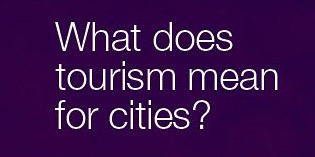 The report on City Tourism is part of a series of UNWTO reports, ranging from UNWTO AM Report Vol. 4 'Global Report on Food Tourism and AM Reports Volume 3 'Global Report on LGBT Tourism to AM Report No.5 Global Report on Aviation.
The report on City Tourism is part of a series of UNWTO reports, ranging from UNWTO AM Report Vol. 4 'Global Report on Food Tourism and AM Reports Volume 3 'Global Report on LGBT Tourism to AM Report No.5 Global Report on Aviation.Urban Cultural Tourism
A big thrust in urban tourism for the last 20+ years has been "cultural tourism," which addresses historic architecture and local history. It's touted for many reasons, especially because improving local cultural assets also serves residents.
From "Cultural Visitor Profile" from the National Assembly of State Arts Agencies:
In a nutshell, cultural tourists compared to the average U.S. traveler:
- Spend more: $623 vs. $457
- Are older: 49 vs. 47
- Are more likely to be retired -- 20 percent vs. 16 percent
- Are more likely to have a graduate degree: 21 percent vs. 19 percent
- Use a hotel, motel or B&B -- 62 percent vs. 55 percent
- Are more likely to spend $1,000+/-: 19 percent vs. 12 percent
- Travel longer: 5.2 nights vs. 3.4 nights
- Travel by air: 19 percent vs. 16 percent.
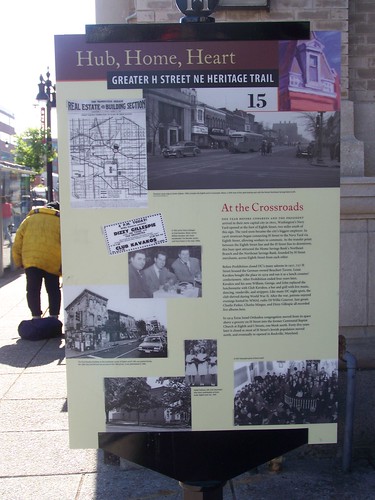 Left: CulturalTourismDC trail sign on H Street NE in Washington, DC.
Left: CulturalTourismDC trail sign on H Street NE in Washington, DC.Because cultural tourists spend more time and money compared to other segments of the tourism market, this is seen as a particularly desirable segment of the market.
In DC, CulturalTourismDC is the leading organization focused on strengthening local history interpretation. In fact, this past weekend was WalkingTownDC (it continues throughout this week), their annual event of tours across the city.
CTDC gets a great deal of funding from city sources, although I would argue that the local tourism destination marketing organization, Destination DC, ought to do more focused funding of development activities for cultural destinations.
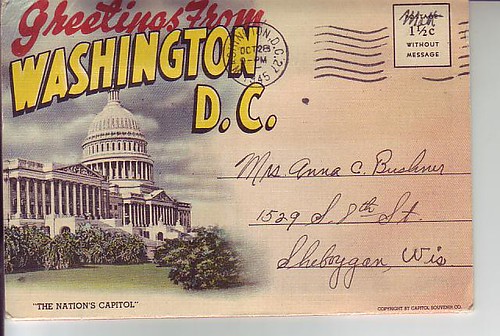 While I am not into calling anything "unique" in terms of comparability, but this is an exception, DC (and Salt Lake City) has a unique tourism marketing problem in that it is defined globally as the Federal City, the US National Capital, and this shapes very specifically what visitors want to consume when they come here:
While I am not into calling anything "unique" in terms of comparability, but this is an exception, DC (and Salt Lake City) has a unique tourism marketing problem in that it is defined globally as the Federal City, the US National Capital, and this shapes very specifically what visitors want to consume when they come here:- US Capitol
- White House
- Museums on the National Mall, especially the Air and Space Museum, but also the Museums of National History and American History
- the Monuments on the National Mall
- Mount Vernon, George Washington's plantation
- Alexandria and Georgetown as old port towns but mostly as commercial districts with historical references
- maybe the Kennedy Center
(and for certain audiences, the Franciscan Monastery and the Shrine of the Basilica of the Immaculate Conception, both in Brookland).
That doesn't leave much time, space, and interest for visiting "local DC." Note how the souvenir postcard folder pictured above doesn't feature "local" historic landmarks, but landmarks related to the federal city.
One of the problems of neighborhood-based tourism in the city is that while you can walk around attractive neighborhoods and appreciate the architecture, or follow a heritage trail, there are few attractions to visit and the retail and restaurant options are limited.
Fortunately, as the city's population increases, it supports more interesting local businesses and a restaurant scene is developing ("In DC, a Street's Grit Gives Way to Glamour" and "A Trendy Turn in Obama's Town" from the New York Times and "DC's Diverse Cuisine," from the Cooking Channel show "Chuck's Eat the Street").
Eastern Market is one of the few neighborhood attractions, but is more likely visited in association with the out-of-town visitor market associated with people who live here. The National Zoo has a mix of local and out-of-town visitors. Union Station is called the city's #1 visited place, with more than 20 million visits each year, but the majority of these visits are associated with local transportation (subway and commuter related railroads) and aren't really tourist visits.
Salt Lake City has a similar marketing positioning problem in terms of how it is perceived as the home and headquarters of the Mormon Church and therefore "everything there to see must be related to the Church." That is decidedly not true--and Utah more generally has been very successful at marketing its outdoor activities as part of its tourism offer.
With the failure of the City Museum here in 2004, and my realization that we don't have a "local" art museum devoted to local and regionally relevant art, I have come to realize how problematic it is that we don't have a wide ranging cultural plan and our funding scheme for local attractions is disjoint--we spend a lot of money, but we don't spend it very well.
I can't even count the number of entries I've written on the topic, but here are some:
-- "Town-City branding or 'We are all destination managers now'"
-- "Tourism Marketing and DC"
-- "You (Don't) really like me--DC and its suburbs"
-- "Who ♥ DC? -- More about DC tourism"
-- "Civic Tourism"
-- "Central Library Planning efforts and the City Museum, how about some learning from Augusta, Maine, and Baltimore"
-- "Cultural resources planning in DC: In the land of the blind, the one-eyed man is king"
Visitability
Last week's New York Times reported about how the local Convention and Visitors Bureau, NYC & Company, has put a visitor center in Macy's, because the store gets a huge number of tourist visits, more than six million annually. See "Tourist-Hungry New York to Put Visitor Center in Macy's."
Over the summer I came across some interesting work from Australia (via the Australian National Tourism and Events Excellence Conference website), including how Destination Melbourne is refocusing their work on the elements which make cities great places to visit, which they call "visitability." The concept is based on a presentation to the organization by Rick Antonson, CEO of Tourism Vancouver, and focuses on five elements equally important to residents and visitors:
- Safety
- Access and transport
- A sense of community – no matter where you are from
- Confidence
- Good infrastructure that serves the people
Bad experiences are memorable too...
Destination Melbourne is creating a "visitability framework" to focus their efforts in making Melbourne a "compelling destination" and driving continuous "improvement in services and experiences" offered to residents and visitors.
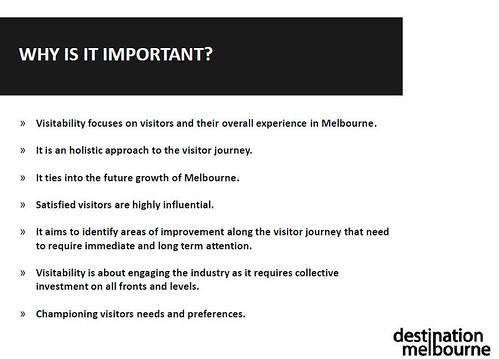
Slide from a presentation by Destination Melbourne at the TEE Conference.
NOTE that in the urban planning world, especially relating to transportation and the built environment--although because of a strong bike helmet requirement, bike sharing has basically failed there, and livability, Melbourne is highly touted and has been picked by The Economist Magazine as the world's most livable city for three years in a row. See "Melbourne ranked world's most liveable city - again" from the Melbourne Age.
So they must be doing something right. Even so, clearly they aren't satisfied with resting on their laurels, and partly this is because when the compare their city to others, "they have no great icons - no Rock, Reef, Opera House, SeaWorld, Disneyland or Giant Pineapple." This motivates them to work harder.
But the visitability concept is applicable to tourism entry points at all levels: sub-local; local; regional; state; and national/international.
Visitor Center policies and case studies
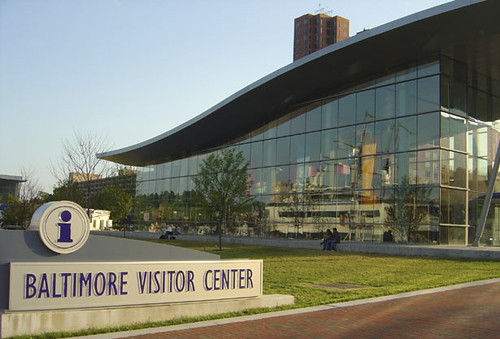 Left: The Inner Harbor is Baltimore's #1 visitor attraction and the Visitor Center is located in a building on the waterfront.
Left: The Inner Harbor is Baltimore's #1 visitor attraction and the Visitor Center is located in a building on the waterfront. Most states have a network of visitors centers, which are typically run by the state tourism agency (which is usually part of the Dept. of Economic Development) in conjunction with local destination marketing organizations.
Cities may have more than one visitors center, a main location definitely, and sometimes subsidiary centers. New York City has main tourist centers and certain business improvement districts, like Chinatown and the Fashion District, run local visitor centers. Pittsburgh has a main center in the Golden Triangle and secondary centers at highly visited attractions such as the Pittsburgh History Center (a great local history museum). Petersburg Virginia has a main visitors center in the city, but they also run a "state" visitors center on I-95, and include some artifacts displays there as well.
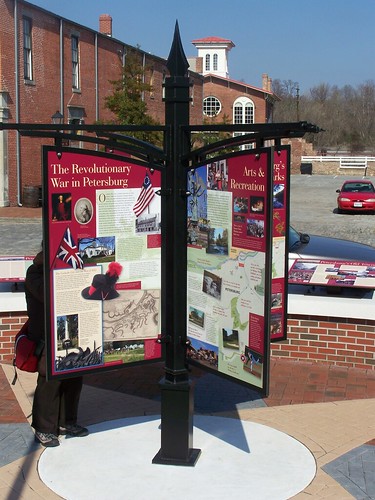 Right: Petersburg has a great set of cultural-historic interpretation signage in the plaza across from their visitor center (which is located in an old railroad station).
Right: Petersburg has a great set of cultural-historic interpretation signage in the plaza across from their visitor center (which is located in an old railroad station).For the most part, DC proper doesn't really have a visitor center, while most other big cities do.
At the state level the hierarchy is bigger centers at main entry points and in big cities, and smaller centers at the city/county level. A third level is information racks that are placed at hotels and other places, and to be included organizations pay for their information to be distributed.
Most US states and the largest cities have excellent tourism development programs, as do many foreign nations, such as the Provinces of Canada.
For example, I use a resources from Canadian provinces such as Nova Scotia (Tourism Destination Assessment Workbook) but there are plenty of good resources and tourism studies from across the US as well, such as this recent study from San Francisco (SAN FRANCISCO ARTS & CULTURAL TRAVEL STUDY), and this report from NYC, New York City Tourism: A Model for Success.
While DC doesn't have a main visitor center comparable to other large cities, there are a number of "main" visitors centers run by federal agencies. The Smithsonian has one. Congress has one (the Capitol Visitors Center). The National Park Service runs the visitors center associated with the White House. It's highly possible that Events DC has created a visitors center in the Carnegie Building--they are supposed to have done so, but I haven't been there for awhile. There is a visitors information desk in the Convention Center. In the past, the DC Chamber of Commerce ran a visitors center buried in the Ronald Reagan Building.
An interesting wrinkle is that compared to traditional visitors centers which are "codification points" for a wide variety of information about nonprofit and for profit visitor experiences, ranging from museums and parks to antique stores, restaurants, and hotels, federal laws preclude at least the CVC and the White House center from providing any other "local" information. (I can't remember the set up at the Smithsonian.) This makes them singularly un-useful from the standpoint of promoting "local DC" to people visiting the city, other than their visits to federal facilities.
In my opinion, DC should have a main visitors center at Union Station as well as the Carnegie Building downtown, across from the Convention Center, and should provide support to permanent secondary centers in certain key commercial districts like Georgetown and Capitol Hill, with the ability to have more temporary set ups (Arlington County has a mobile vehicle, Downtown Bethesda has a rolling kiosk, Montreal supports both permanent secondary centers such as at the Mont Royal Metro Station and temporary movable kiosks such as in the summer months in "The Village"). The federal visitor centers should be integrated into this system, and an attempt should be made to get these facilities to carry other information relevant to visitors.
I have written about this more extensively: "A National Mall-focused heritage (replica) streetcar service."
Left: the Silver Sightseer streetcar in front of the US Capitol, sometime before October, 1962.
Besides marketing their state and providing information to potential and actual visitors,Tourism Queensland offers a wide variety of resources to the industry, including an active support and research program for "Visitor Information Centers."
-- Visitor Information Center Policy Resource Kit, Tourism Queensland
-- Visitor Information Center case studies, Tourism Queensland
DC does get from 13 million to 17 million visitors annually, and while that is only about 1/3 of the number visiting NYC, it's still a lot. It would be good to benchmark the area's visitor centers, and DC's offer against what it argues are peer cities.
Consideration of the findings by Tourism Queensland can inform improvement efforts here.
Airports, visitability and international visitors:
Bureaucracy dooms the brand promise of Brand America
Another "problem" is that three of the main entry points into "Washington" aren't in DC proper-- National Airport and Dulles Airport in Virginia and Marshall-BWI Airport in Maryland. Each has a visitor information desk, but none of the services are comparable to the airports with the best visitor information set ups.
Plus, at Dulles Airport especially, the experience for visitors leaves a lot to be desired, which is something that Tyler Brule of Monocle Magazine mentions from time to time, especially in his weekly column in the Financial Times, where he has been very negative about Dulles Airport, because of big problems with the customs entry process. From "Let’s play ‘Guess where I am?’":
I’ve just come off an airliner and it’s absolute pandemonium. There are gate agents screaming for transfer passengers, there are sniffer dogs, there are loads of immigration officers and there’s a general sense of disorganization. My fellow passengers look bewildered and flustered after their eight-hour, 45-minute flight from Frankfurt, and there’s a lot of huffing and puffing as we’re divided up into groups of arriving passengers and “connectors”. ...
[description of 1,000 people waiting to go through ICE at shift change, when many people leave their posts, with the result that even fewer agents are there to work with the passengers.]
As I approach the desk, I feel like giving the young gentleman a lecture about how bad this whole performance is for Brand USA – particularly on top of a whole week of television reports about the new fee that visitors will have to pay to get a visa and how these funds will be used to create a campaign to encourage more tourism to the US. I want to ask him if he (and his bosses not far away in the District of Columbia) think a 90-minute wait in a dumpy airport is any way to welcome the world and if his department is really that interested in having people visit the US.
Combine this experience, plus the then less than sterling experience of getting to the city from the airport--this will change in a few years when there is subway service there, but the location of the subway station will be less than ideal--and then think about what this says not only for BrandAmerica ("Brand USA, a campaign to lure back foreign tourists — and their money" Washington Post and "Re-branding America" from the Sunday Boston Globe) but BrandDC (see the blog entry "Creating Brand Washington"), and is it any reason that the number of international visitors to the US is falling?
Note that while the FT piece is from 2011, the problem at Dulles continues. See "Editor's note: BWI is the big winner in the battle for passengers" from the Washington Post. And the MWAA has responded with a advertising campaign. But I would aver the problem is more structural and fundamental--something that marketing can fix, but advertising can't.
An evaluation of area airports in terms of the "visitability" approach is long overdue. Also see the past blog entry, "More on transportation to the DC area airports." which discusses airports planning at the regional scale.
Local airports and the provision of visitor information
That the area's major airports are in Maryland and Virginia and not DC complicates the realization of my recommendation that there should be a coordinated set of visitor centers at the region's airports, as part of the DC city network of visitor centers. There are information desks at each of the airports with some visitor information. But there should be a much better offering than there is currently.
But I don't claim it would be easy to get the airports and Destination DC to come together and do this. Also, Maryland has visitors centers north and south of Baltimore on I-95 and they might think that this suffices, although such facilities only target automobiles, and miss out on reaching people on mass transit of various sorts.
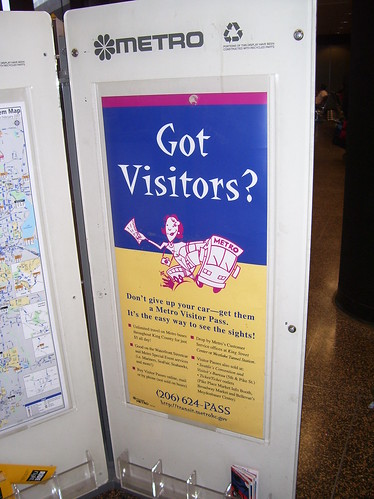
Right: King County, Washington Metro used to have a kiosk in the airport terminal promoting bus transit use. Now that they have a light rail station at the airport, they seem to have removed marketing materials from within the airport terminal.
Airports and transit
Transit wayfinding needs to be improved at all the airports, especially to be able to reach people who are less accustomed to riding transit, and therefore need more information in order to be comfortable in choosing it.
That's discussed here, "More on airport-related transit/transit for visitors."
Comprehensive airports planning at the regional scale would address public transit issues as well. It's really a surprise (not) that this isn't done.
A key element of appealing to international visitors is a reasonably efficient transit system for getting to the major lodging centers in the metropolitan area. This will improve for Dulles Airport with the extension of Silver Line service there sometime within the next 5-6 years.
Transit service to BWI Airport is decent, considering the distance from DC and it is improving as the regional commuter railroad service MARC will be adding weekend service starting later this year--currently MARC serves the airport during the week and Amtrak all the time. Light rail service to the airport is available from Baltimore, and WMATA runs a bus from the end of the Green Line Metro at Greenbelt.
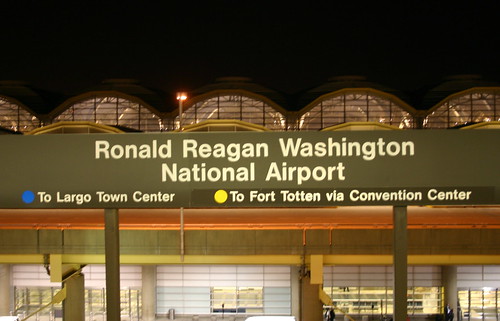 Left: Flickr photo by Elvert Barnes.
Left: Flickr photo by Elvert Barnes.National Airport has great transit service when the Metrorail is running--the subway station is conveniently located for reaching both terminals--and paltry service when the subway isn't running and airplanes are still landing and taking off.
Fortunately, WMATA is proposing changes to bus service, by extending service from a DC-based bus line when Metrorail is closed, to address this problem.
Conclusion
DC needs to truly up its game as far as visitability, cultural tourism, and visitors centers are concerned. World Tourism Day and other tourism promotion activities are a way to call attention to the need for better tourism planning, development, and management activities in DC.
Labels: advertising and marketing, airports, building a local economy, cultural heritage/tourism, economic development, market segmentation, tourism, visitor services





5 Comments:
I think neighborhoods and Metro need to establish more cohesive joint identities. While it's not on the Metrorail, Mt. Pleasant has local maps developed by the BID showing all different neighborhood retail outlets. I really think these should be centrally located in or around all Metrostations. They couldnt probably even generate some advertising revenue by allowing businesses to upgrade to more prominent mention. If I as a native am still unfamiliar with the areas around a lot of places how are tourists going to know what is around?
http://urbanplacesandspaces.blogspot.com/2013/09/transit-stations-and-placemaking.html
And I am going to do another piece on this, based on 3 bus stop-station beautification projects in the UK.
Mostly random feedback, one big point:
Big point: Not sure the market for "cultural tourism" will ever be that high in DC. Not saying it doesn't exist. My parents will be coming in a week and we'll indulge in what looks like cultural tourism. But no hotel, which is probably the biggest dollar factor.
Minor random points:
Also probably ignoring the international element. I'd say a huge chunk of DC tourism is foreigners. A lot of have money. A lot don't -- there was a large group of South Africans I almost assaulted on Saturday because they were clogging up the K st circulator.
You may want to consider the death of the 5A bus as well.
Just putting a smartrip vending card machine -- or regular vending machine -- at Dulles would help. Many foreigners don't have exact change for a bus.
Free WIFI is a big help for international tourists. Dataplans are very expensive. Partner with FON or something like that.
I'd dream of a DC unified calendar. Museum, think tank events, etc. So much here. Library. Book talks. All stuff that ties into cultural tourism. I understand that government may not be capable of doing this. But I remember trying to get DC to leverage Bhangra Blowout 10 years ago and it wasn't like they even heard of it.
1. Interestingly, I think definitionally CT visits do include going to the federal destinations. But this is distinct from the local.
2. I agree with you about intl. tourism. The fall off after 9/11 specifically devastated certain segments of the regional market. I'm not sure until then that Georgetown e.g. understood how much of their tourist capture was of international visitors.
I don't have the numbers off hand, but foreign tourists spend significantly more on average than in-country tourism.
3. WRT your parents, in theory, by their not having to pay for hotel, they can spend more money on other stuff.
one of my complaints about ec. impact studies of events is that the bulk of the dollars are spent on rooming nights, and since most hotels are not locally owned, a goodly amount of the revenue doesn't stay local, although sure money is spent on food, labor, tax receipts, etc.
4. wifi is an interesting point. There was an article in T&Leisure about this wrt US people traveling overseas.
5. Unified calendar would be another element of a revitalized destination dc offer.
6. and somehow with that calendar and other elements, the various authorities are going to have to work together on a regional basis.
I have had some problems with that because of how MoCo, ArCo and National Harbor market "against" DC for tourism, but somehow we have to figure out how to get around that.
what I meant in point 1 is that you're right, it might be hard for BrandDC as opposed to BrandUSAinDC to compete on cultural tourism dimensions because of how BrandUSAinDC overwhelms the local.
Post a Comment
<< Home